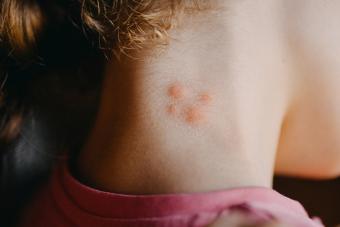
When you think of skin fungus, is your first reaction one of disgust? Although many people feel that way, skin fungus is actually a common problem and one that's usually easily treated.
Causes of Skin Fungus
Common fungal infections can be transmitted from person to person. Some infections get passed around among preschoolers and elementary school children, because they tend to come in contact with each other while playing.
Many fungi like warm, damp places. They can live on the shower floor at the gym or in a damp restroom at the pool. These fungi can infect the skin and nails. Some fungi live on our bodies normally, without ever making their presence known. Environmental changes can cause an overgrowth of fungi. Summer heat causes skin folds to stay warmer and moister than usual. This allows the fungi grow more quickly causing a rash.
Common Infections
The names we use for common skin fungus infections are a little confusing. For example, "ringworm" isn't a worm at all, but a type of fungus. Athlete's foot and jock itch are fungal infections, too. The medical term for all three of these infections is "tinea."
There are several types of fungus which cause these infections. Collectively, they're known as "dermatophytes" and most of the time it doesn't matter which specific one you have.
Ringworm
Ringworm is often seen on pre-school and school-age children. It tends to start out as one or more small red dots that gradually develop into raised, bumpy, or scaly rings, with a circle of normal skin at the center. It's usually itchy. The rings look like they could be made by worms but that is really just the way the fungus grows. Not all cases of ringworm form the classic ring-shape and they won't always have the clear center. Ringworm is usually diagnosed by its appearance, but your doctor may scrape off some of the flaky skin to confirm the diagnosis. Your physician will probably prescribe a skin cream or ointment which should make the ringworm go away.
Tinea Capitis
When the skin fungus that causes ringworm infects the scalp, it's called tinea capitis. Capitis is Latin for "head." On the scalp, you can expect to see a raised bump instead of a ring. It might be itchy or tender. The hair in the affected area will often break off or fall out. Treating tinea capitis is a little tougher than treating regular ringworm. Creams won't usually do the trick. The usual treatment is an oral antifungal medicine.
Athlete's Foot
Athlete's foot is called tinea pedis. Pedis is Latin for "foot." It gets its name from the fact that athletes, who spend a lot of time in sweaty tennis shoes and walking on damp locker room floors, are often exposed to the infection. Despite the name anyone can develop athlete's foot. Athlete's foot is contagious, and it's easily passed from person to person, either by direct contact or via shower floors and other damp places. It generally affects the soles of the feet and can also develop between the toes. Nails are sometimes affected too. Skin may look red or flaky and blisters may form. The feet may itch, sting, or burn.
Once it settles in, athlete's foot usually requires medication to cure. Over-the-counter creams and powders are a good start. For severe infections, or ones that don't go away in a week or two with over-the-counter treatment, a stronger prescription medicine may be needed. Changing shoes regularly, wearing cotton or other breathable socks, and drying the feet thoroughly after bathing will all help. Wearing flip-flops in public showers can help prevent infection.
Jock Itch
Jock itch is called tinea cruris. It affects the groin area and sometimes the upper thighs. Again, this infection is common among athletes, but anyone can get it. It's related to increased sweating, which leads to dampness in the skin folds at the tops of the legs. Summer heat, humidity or wearing tight clothes that doesn't let skin breathe can also cause jock itch. Obese people, who tend to have deeper skin folds, are susceptible, too.
Jock itch is caused by fungi that normally live on our bodies. They are usually harmless but the damp, warm environment created in the skin folds is a perfect place for them to grow. Affected areas will have a reddish rash with raised edges. Skin will itch or burn and may feel tender or chafed. It may be appear flaky or cracked.
Like athlete's foot, jock itch should go away in a couple of weeks with over-the-counter medicines. If it doesn't, you need to see the doctor for a full evaluation and a prescription.
Proper Fungus Care
Once you have been diagnosed with a fungus, it is important to act fast. Follow the treatment protocols for the specific fungus to the letter; this will help keep the infection from spreading and will encourage speedier healing. If home remedies and over-the-counter medicines don't do the trick, don't hesitate to visit your dermatologist.







